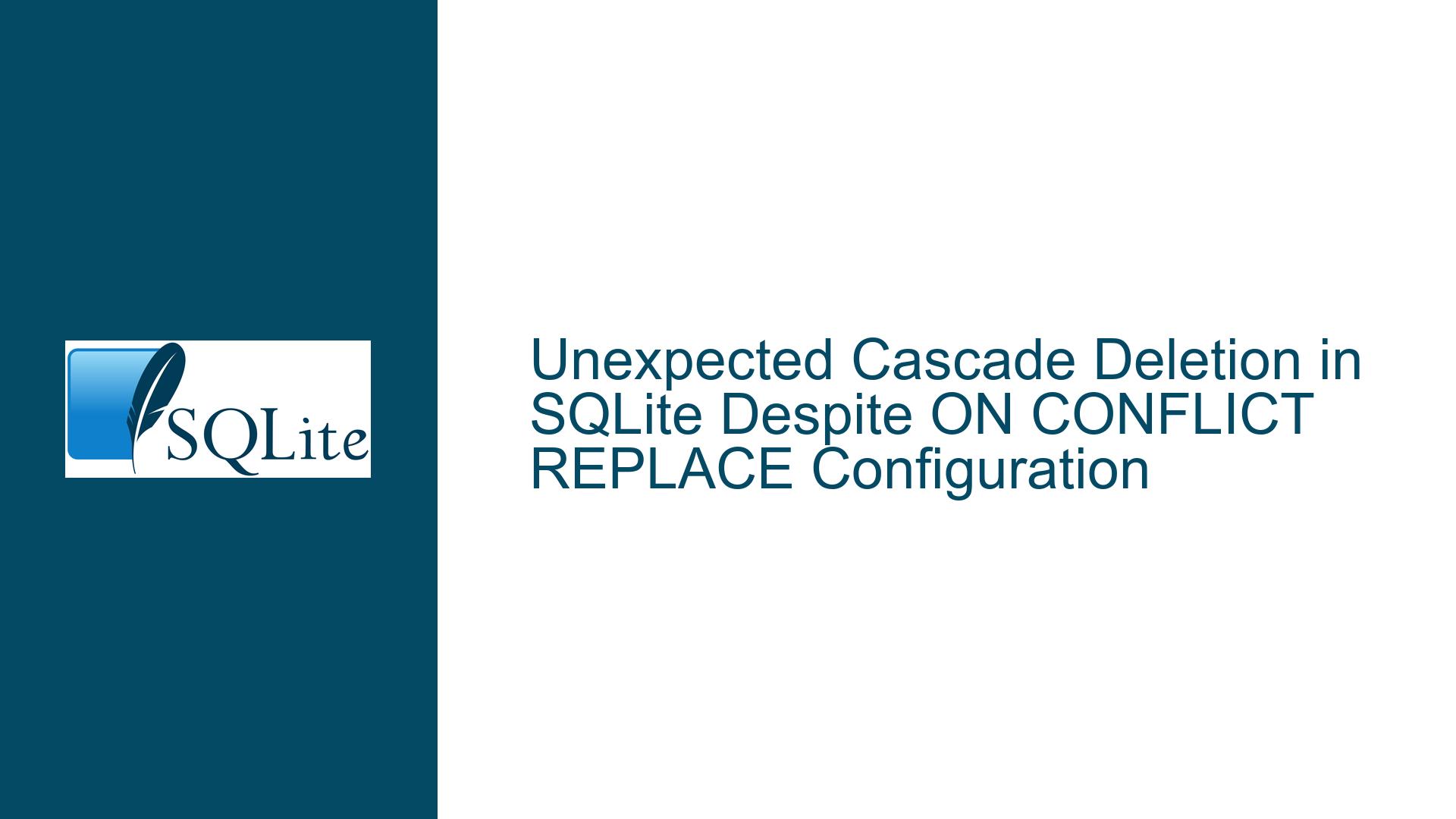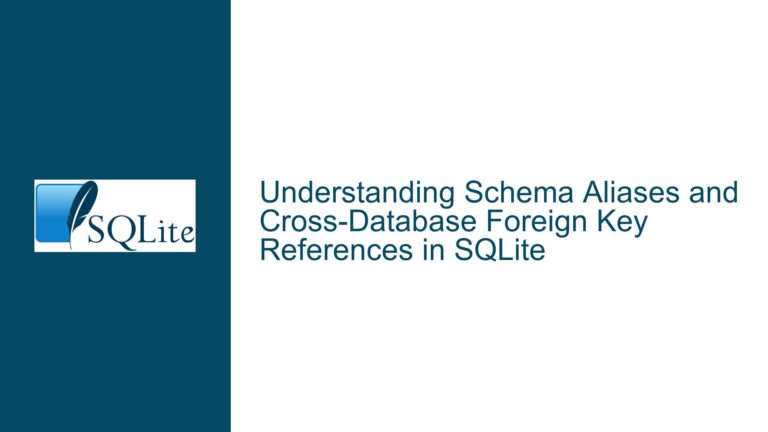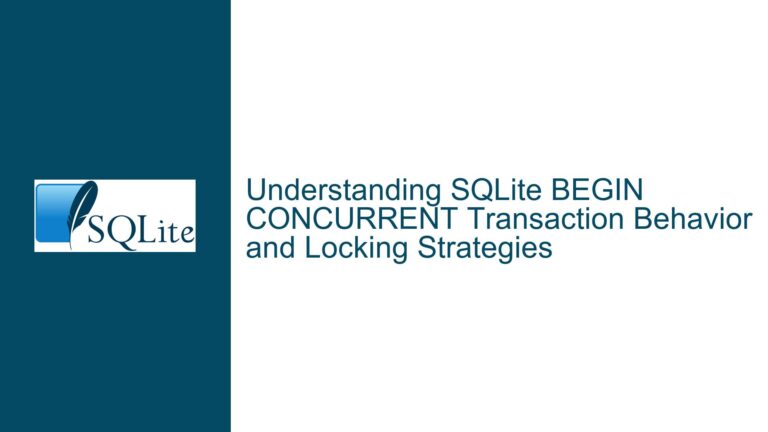Unexpected Cascade Deletion in SQLite Despite ON CONFLICT REPLACE Configuration
Primary Key Conflict Resolution and Foreign Key Cascading Interactions
Issue Overview
The problem arises when attempting to update a primary key value in a parent table (ids) that uses ON CONFLICT REPLACE, resulting in unintended deletion of associated records in a child table (some_data) due to foreign key constraints configured with ON DELETE CASCADE. The user expects that updating the primary key from 2 to 1 in the ids table should not remove the corresponding row in some_data with id = 1, since the final state of the ids table still contains id = 1. However, the row in some_data is deleted.
The confusion stems from two mechanisms interacting:
- Primary Key Conflict Handling: The
ON CONFLICT REPLACEclause in theidstable’s primary key definition. When a new row is inserted or an existing row is updated in a way that violates the primary key uniqueness constraint, SQLite deletes the conflicting row before inserting/updating the new row. - Foreign Key Cascading Actions: The
ON DELETE CASCADEclause in thesome_datatable’s foreign key definition. When a row in the parent table (ids) is deleted, all associated rows in the child table (some_data) referencing that row are also deleted.
In the provided example, the UPDATE statement UPDATE ids SET id = 1 WHERE id = 2 triggers a primary key conflict because id = 1 already exists. To resolve this conflict, SQLite first deletes the existing row with id = 1 (due to ON CONFLICT REPLACE), which activates the ON DELETE CASCADE action on the some_data table, removing the row with id = 1. The system then inserts a new row with id = 1 (the updated value from the original row with id = 2). The result is that the some_data row linked to id = 1 is permanently deleted, even though id = 1 still exists in the ids table after the update.
The user’s attempt to disable recursive triggers (PRAGMA recursive_triggers = OFF) is irrelevant here because the deletion is caused by foreign key cascading, not triggers. SQLite’s foreign key cascade actions operate independently of trigger recursion settings.
Root Causes: Conflict Resolution and Constraint Propagation
Possible Causes
Primary Key Conflict Resolution via Deletion
TheON CONFLICT REPLACEclause on theidstable’s primary key forces SQLite to delete the existing conflicting row before performing the update. This is a delete-then-insert operation under the hood. Even though the final state of theidstable appears to retainid = 1, the intermediate step of deleting the original row triggers the foreign key’sON DELETE CASCADEaction.Foreign Key Cascade Configuration
The foreign key insome_datais explicitly configured withON DELETE CASCADE. This means any deletion in the parent table (ids) will propagate to the child table (some_data), regardless of whether the parent row is reinserted later. The cascade is a direct consequence of the foreign key definition and operates independently of the application’s intent to retain the child data.Misunderstanding of SQLite’s Conflict Resolution Mechanics
TheON CONFLICT REPLACEbehavior is often misinterpreted as a simple "overwrite" operation. In reality, it is a two-step process: delete the conflicting row, then insert the new row. This distinction is critical when foreign key constraints are involved, as the deletion phase activates cascading actions.Absence of Foreign Key Enforcement Controls
Foreign key enforcement in SQLite is disabled by default. If the user enabled it viaPRAGMA foreign_keys = ON, cascading actions become active. If foreign keys are enabled, cascades will execute even if triggers are disabled, as these are separate mechanisms.Data Modification Order and Transaction Scope
The sequence of operations—insertingid = 1, insertingid = 2, then updatingid = 2to1—creates a dependency chain where the update operation’s conflict resolution indirectly affects the child table. Without explicit control over transaction boundaries or foreign key enforcement, the cascade occurs as a side effect.
Mitigation Strategies and Schema Design Adjustments
Troubleshooting Steps, Solutions & Fixes
1. Disable Foreign Key Enforcement Temporarily
If retaining the child data is paramount, disable foreign key checks during the update operation. This prevents the cascade from executing.
Steps:
PRAGMA foreign_keys = OFF; -- Disable foreign key enforcement
BEGIN TRANSACTION;
UPDATE ids SET id = 1 WHERE id = 2; -- Perform the update
PRAGMA foreign_keys = ON; -- Re-enable enforcement
COMMIT;
Risks:
- Temporarily disabling foreign keys risks creating orphaned rows if other operations occur without proper safeguards.
- Ensure the database is in a consistent state before re-enabling foreign keys.
2. Avoid ON CONFLICT REPLACE for Primary Keys
Replace the ON CONFLICT REPLACE clause with manual conflict resolution. For example, use INSERT OR IGNORE or application logic to handle duplicates.
Modified Schema:
CREATE TABLE ids (
id INTEGER PRIMARY KEY -- Remove ON CONFLICT REPLACE
);
Application Logic Adjustment:
Before inserting/updating, check for existing IDs and handle conflicts explicitly:
INSERT OR IGNORE INTO ids (id) VALUES (1); -- Silently skip conflicts
Benefits:
- Eliminates the automatic deletion of conflicting rows, preventing unintended cascades.
3. Manual Update of Child Table Before Parent Table
Update the foreign key values in the child table (some_data) before modifying the parent table (ids). This avoids triggering ON DELETE CASCADE.
Steps:
BEGIN TRANSACTION;
-- Temporarily disable foreign key checks if necessary
PRAGMA foreign_keys = OFF;
-- Update child table to reference the new ID
UPDATE some_data SET id = 2 WHERE id = 1;
-- Update parent table
UPDATE ids SET id = 1 WHERE id = 2;
-- Re-enable foreign keys and commit
PRAGMA foreign_keys = ON;
COMMIT;
Considerations:
- This approach requires prior knowledge of the new ID value.
- Ensure atomicity via transactions to prevent partial updates.
4. Use Deferred Foreign Key Constraints
Defer foreign key constraint checks until the end of the transaction. This allows reinserting the parent row before constraints are verified.
Modified Schema:
CREATE TABLE some_data (
id INTEGER REFERENCES ids (id)
ON DELETE CASCADE
ON UPDATE CASCADE
DEFERRABLE INITIALLY DEFERRED
);
Steps:
BEGIN TRANSACTION;
UPDATE ids SET id = 1 WHERE id = 2; -- Deletes id=1, inserts id=1
-- The deferred constraint checks occur here, after the update
COMMIT;
Limitations:
- Deferred constraints are not supported in all SQLite environments.
- Requires schema modification.
5. Replace ON DELETE CASCADE with Application-Managed Integrity
Remove cascading actions from the foreign key and handle deletions/updates programmatically.
Modified Schema:
CREATE TABLE some_data (
id INTEGER REFERENCES ids (id)
ON DELETE NO ACTION
ON UPDATE NO ACTION
);
Application Logic:
- Before deleting or updating a parent row, manually update or delete child rows.
Drawbacks:
- Increases application complexity.
- Requires thorough testing to maintain referential integrity.
6. Use a Surrogate Key and Unique Constraints
Replace the natural primary key with a surrogate key (e.g., an auto-incrementing integer) and enforce uniqueness on the desired column separately.
Modified Schema:
CREATE TABLE ids (
internal_id INTEGER PRIMARY KEY,
public_id INTEGER UNIQUE ON CONFLICT REPLACE
);
CREATE TABLE some_data (
public_id INTEGER REFERENCES ids (public_id)
ON DELETE CASCADE
ON UPDATE CASCADE
);
Workflow:
- Update
public_idwithout affecting the surrogateinternal_id. - Cascades are tied to
public_id, which can be updated without deleting the parent row.
Advantages:
- Isolate identity changes from referential integrity.
7. Audit Trigger-Based Solutions
Although the original issue does not involve triggers, creating triggers can provide finer control over cascading actions.
Example Trigger:
CREATE TRIGGER prevent_fk_cascade
BEFORE DELETE ON ids
FOR EACH ROW
WHEN EXISTS (SELECT 1 FROM ids WHERE id = NEW.id)
BEGIN
-- Abort deletion if the ID is being reinserted
SELECT RAISE(IGNORE);
END;
Caveats:
- Triggers add overhead and complexity.
- Requires careful testing to avoid infinite loops or unintended side effects.
Final Recommendations:
The optimal solution depends on the specific use case:
- For ad-hoc updates, temporarily disabling foreign keys is quick but risky.
- For long-term stability, avoiding
ON CONFLICT REPLACEor using surrogate keys provides robust data integrity. - Manual child table updates offer precision but require additional application logic.
By understanding the interplay between conflict resolution and foreign key constraints, developers can design schemas that balance flexibility with referential integrity.





